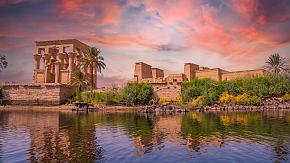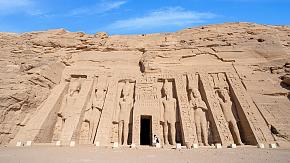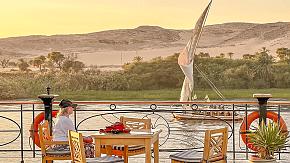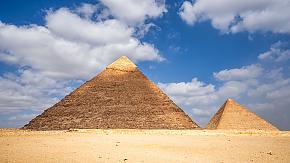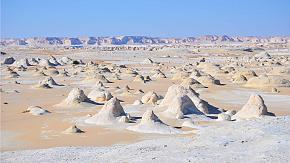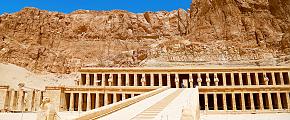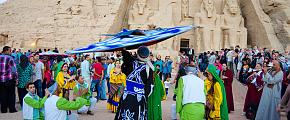Top Things to Do in Egypt: Essential Experiences
Known as the land of pharaohs, Egypt has always been a fascinating and mysterious country for many people. Even just hearing the name may conjure up images of the great pyramids. This remarkable civilization offers an amazing variety of things to do. Here are some of the best travel experiences recommended for first-time travelers to Egypt.
Visit the Egyptian Pyramids
 Sphinx & Pyramid in Giza
Sphinx & Pyramid in Giza
Seeing the iconic Egyptian pyramids is absolutely the most popular activity on an Egypt tour.
The most famous and awe-inspiring Egyptian pyramids are found at Giza on the outskirts of Cairo. Constructed nearly 4,000 years ago, the Pyramids of Giza, including the Great Pyramid of Khufu, the Pyramid of Khafre, and the Pyramid of Menkaure, are the only surviving wonders of the ancient world. Standing beside the Giza pyramid complex is the legendary Sphinx, a huge, reclining limestone statue that has the body of a lion and the head of a human. These incredible structures are testaments to ancient Egypt's power and engineering skills.
It is recommended to visit the pyramids of Giza in the early morning when they are at their most stunning and fewer crowds. Some images show the Giza Pyramids sitting in the desert, which makes people think it's far from the city. But it is actually quite close to downtown Cairo. With about a 10-minute drive, you'll get there.
If your time allows, the Step Pyramid (also called the Pyramid of Djoser) at Saqqara is also worth visiting. The shape of this pyramid is different from the others, and it is the oldest pyramid in Egypt, built between 2630 and 2621 BC.
Cruise the Nile River
 Scenery on a Nile Cruise
Scenery on a Nile Cruise
The Nile River is the longest river in the world and has been vital to ancient Egyptian civilization and modern Egypt. Many of the famous sites are located on the banks of the Nile. There is no doubt that a Nile River cruise is one of the most essential Egyptian experiences.
Away from the hustle and bustle of the city, a river cruise on the Nile is wonderfully relaxing and peaceful. When traveling between different places, you can observe rural scenes along the river that have changed little for thousands of years.
The most popular cruise routes run between Luxor and Aswan, covering a large concentration of historic sites such as the Valley of the Kings and Queens, Temple of Horus, Karnak Temple Complex, and Luxor Temple. There are different vessels to choose from, from traditional paddle steamers to luxurious modern cruise ships that are equipped with swimming pools. Some modern cruise ships offer a variety of entertaining, onboard evening activities like cocktails, dancing, and fancy dress parties.
If you travel during the hot summer months between June and August, it's best to choose an air-conditioned cabin. What vessel you opt for depends on your interests and budget. If you like, Odynovo Egypt travel specialists are always pleased to create a tailor-made Egypt tour with a Nile River cruise around your budget and preferences.
Visit the Grand Egyptian Museum
 Inside Grand Egyptian Museum
Inside Grand Egyptian Museum
Experience Egypt's incredible history at the Grand Egyptian Museum (GEM), now in its soft-opening phase. As the biggest archaeological museum in the world, GEM takes you on a journey through time with 12 main galleries and over 15,000 artifacts from Egypt's earliest days to the Graeco-Roman period. Each gallery tells the story of Egypt's great rulers, daily life, and beliefs about the afterlife. While the famous Tutankhamun collection won't be shown until the official grand opening, there's still plenty to explore.
For years, the old Egyptian Museum in Cairo has displayed Egypt's most valuable treasures, but GEM offers a new and exciting way to experience them. Located near the Pyramids of Giza, this museum is a must-visit for anyone wanting to dive deeper into Egypt's past.
Wander Khan El-Khalili Bazaar
 Stores in Khan El-Khalili Bazaar
Stores in Khan El-Khalili Bazaar
Home to over 20 million inhabitants, the Egyptian capital of Cairo is both chaotic and charming. To feel the city's energy, the Khan el Khalili Bazaar is the top choice.
Established in the 14th century, this bustling bazaar is among the world's first markets, and still the favorite place for locals to buy everything from soap powder to clothing, and spices. You can wander through the narrow, maze-like streets and absorb the unique sounds, sights, and smells of this medieval market. This offers you glimpses into Egyptian culture and its way of life. If you are hungry or thirsty, there are restaurants, street food stalls and coffeehouses to fill your stomach. Before you leave, don't forget to shop for some souvenirs such as semi-precious stones, toy camels, and alabaster pyramids. Haggling is allowed but should be done with smiles and humor.
Explore the Valley of the Kings
 Inside the Valley of the Kings
Inside the Valley of the Kings
The ancient Egyptians not only constructed massive public structures to their pharaohs such as pyramids, they also built elaborate, hidden underground tombs for them and their wives. On the west bank of the Nile near Luxor, you will find the most majestic of such mausoleums, the Valley of the Kings.
Pharaohs of the New Kingdom were mummified and buried here from as early as the 16th century BC. There are 63 tombs in the valley. They contained everything a ruler might need in their afterlife, from masks like the dazzling golden masks found with King Tutankhamun to mundane items such as clothes, furniture, and jewelry, food and drink for royal feasting. Seeing these tombs offers insights into the pharaohs' lives. In order to preserve the tombs, a limited number of tombs are open for viewing at any one time, with the rest closed for restoration.
Tip: Photography is not allowed in the tombs, but you may like to buy postcard images from the vendors outside the tombs as a memento of your visit. It is advisable to leave your camera somewhere safe as visitors cannot take them through the entrance gates.
Visit Temples in Luxor
 Sunset View in Luxor Temple
Sunset View in Luxor Temple
Luxor, once the great city of Thebes, is often called the world's largest open-air museum and for good reason. This historic city, inhabited since 3,200 BC, is home to some of the most awe-inspiring temples and monuments in Egypt. Among its many treasures, two stand out: Karnak Temple Complex and Luxor Temple.
Spanning over 2 square kilometers (494 acres), Karnak is Egypt's largest temple complex, built and expanded over 1,500 years. The site is a maze of sanctuaries, towering pylons, and sacred obelisks, including Queen Hatshepsut's towering obelisk, the tallest surviving ancient obelisk in the world.
One of Karnak's most breathtaking sights is the Hypostyle Hall in the Temple of Amun-Ra, a vast forest of 134 towering columns that once supported a massive stone roof. This hall alone is enough to leave visitors in awe, making Karnak a must-see on any Egypt itinerary. The temple is open daily from 6 AM to 6 PM.
Built by generations of pharaohs—including Amenhotep III, Ramses II, and Tutankhamun - Luxor Temple was one of the most important religious sites in ancient Egypt. It was also dedicated to the Theban Triad and played a key role in the Opet Festival, an annual celebration where statues of the gods were paraded from Karnak to Luxor Temple. For the best experience, visit early in the morning to beat the crowds or at sunset for a magical golden-hour glow. At night, the temple is beautifully illuminated, creating an unforgettable sight.
Marvel at the Abu Simbel Temples
 The Great Temple of Abu Simbel
The Great Temple of Abu Simbel
Located 230 km (140 miles) southwest of Aswan, Abu Simbel is home to two breathtaking temples built by Pharaoh Ramses II. These masterpieces are famous for the Sun Festival, held twice a year (February 22 & October 22), when the rising sun perfectly aligns to illuminate the statues of Ramses II, Amun, and Re-Harakhte, while Ptah, the god of darkness, remains in shadow. The festival also features music, dancing, and cultural celebrations.
In the 1960s, the construction of the Aswan Dam threatened to submerge these temples under Lake Nasser. In a remarkable feat of modern engineering, they were relocated block by block to their current site, preserving their original solar alignment.
Dive in the Red Sea
 Snorkeling & Diving in the Red Sea
Snorkeling & Diving in the Red Sea
After exploring Egypt's ancient wonders, it is highly recommended to head to the Red Sea coast for a relaxing and adventure-filled escape. Stretching over 1,000 km (620 miles) from Suez to the Sudanese border, this coastline offers pristine beaches, luxury resorts, and world-class diving spots.
Top diving destinations include Hurghada, Marsa Alam, Sharm El Sheikh, and Dahab, where you can explore vibrant coral reefs and fascinating sea creatures. Most hotels offer diving excursions, even for beginners, with professional instructors to guide you.
The ideal time to dive in the Red Sea is March to May and September to November. During these months, water temperatures are pleasant, visibility is excellent, and marine life is thriving.
Tour Bibliotheca Alexandrina (Library of Alexandria)
 Scripts on the Wall of the Alexandria Library
Scripts on the Wall of the Alexandria Library
Once home to the legendary Lighthouse of Alexandria and the Great Library, Alexandria was a center of culture and learning. Though both were lost, the city revived its legacy with the Bibliotheca Alexandrina.
This architectural masterpiece, designed to resemble the rising sun over the Mediterranean, features granite walls engraved with 120 scripts. Its vast reading room, 16 meters (52 feet) below sea level, holds 8 million books. The library also houses specialized museums, including the Antiquities Museum with Pharaonic and Graeco-Roman artifacts and the Manuscript Museum, home to rare texts and the only surviving scroll from the original Great Library.
Located in Qism Bab Sharqi, Alexandria, the library offers guided tours in English, French, and Arabic and is open Sunday to Saturday at varying hours. Visitors are encouraged to spend at least half a day exploring this modern hub of knowledge. Besides, children under six are not allowed in the reading room, but daycare services are provided.
Customize Your Trip to Egypt Now
Feeling inspired? Now it's time to tick Egypt off your bucket list. A private tailor-made trip is the best way to experience Egypt and it is easier than you think. Just tell your personal travel specialist where you want to go and what you like to see, then a personalized Egypt itinerary will be available to you in no more than 24hours.
Quick Question
What Our Clients Say
Explore the latest verified reviews of Odynovo's travel services on Tripadvisor, Google, Trustpilot, Product Review and more trusted platforms.
